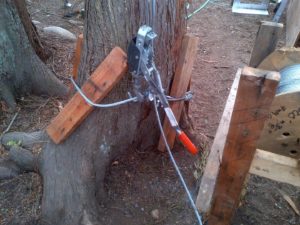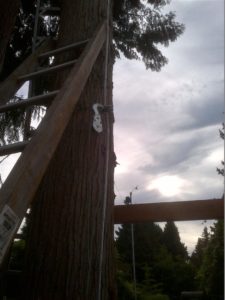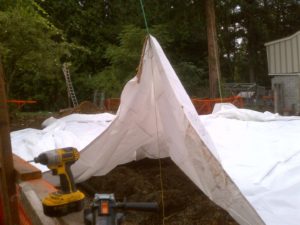Tarp Raising
Well – it took the better part of 5 days but the tarp is up. I tensioned the last point this morning.
This has been an interesting process full of frustration and learning. First thing learned is just how heavy something like this could be and the tension it would put on the attachment points. As mentioned earlier, the original nylon chord was not nearly up to the task, so I switched out to galvanized cable for all of the attachment points.
Then there was the dynamics of what shape the tarp would take depending on where it was being pulled. I needed to rotate the tarp as mush as possible on the main overhead cable because the trees the cable were attached to were diagonal through the build site. I also needed a lot more of the tarp on the east side of the main line than the west (again due to where the trees were in relation to the new build).
I also lost a lot of time going back and forth to the lumber store for clamps as the scope unfolded and the design was modified. I cleaned the local Dicks lumber out of two of the sizes.
But the majority of the time was just spent tensioning each line. This would entail creating a hard point on a tree to attach one end of the come-a-long and then clamping a metal ring to the rope or cable to attach the other end of the come-a-long. The cable or rope then would typically be run through an eye screw that was screwed into the tree. Once tension had been placed on the cable, I would install a clamp on the cable on the outboard side of the eye bolt attachment point to hold the tension while I disconnected the winch and re-rigged to do the next pull. This process was often repeated 5-10 times until that cable was tight and the entire process was often repeated if the attachment point had to be shifted or for instance when I switched from rope to cable. The end result was that most of the attachment lines took an average of 4-5 hours each and I had 5 major points.
None of this would have been possible if there was not tall and strong enough trees available and great neighbours allowing me to use their trees. So, while I still contend that this is an excellent idea for new construction or renovations, it will not be possible in a great many sites.
The installation has garnered a lot of attention from passers-by wondering what the heck I am doing. Some say I am nuts and some say why is this not done more. I explain that this is my cheap way of imitating what they do in a neighbouring municipality where they will often build a aluminum infrastructure over the build area that is closed off with glass or plastic panels. Only difference is mine is going to come in below $2000 and the fancy version is reported to costs $60K or more.
I have tested and have the rain runoff taken care of but realized at 2AM last night I did not account for snow load. Lets hope it is a typical Vancouver winter with a minimum of snow or it will get interesting as I figure out ways to dump any accumulated snow. One obvious method will be to try and wash it off.








Thanks for visiting.
